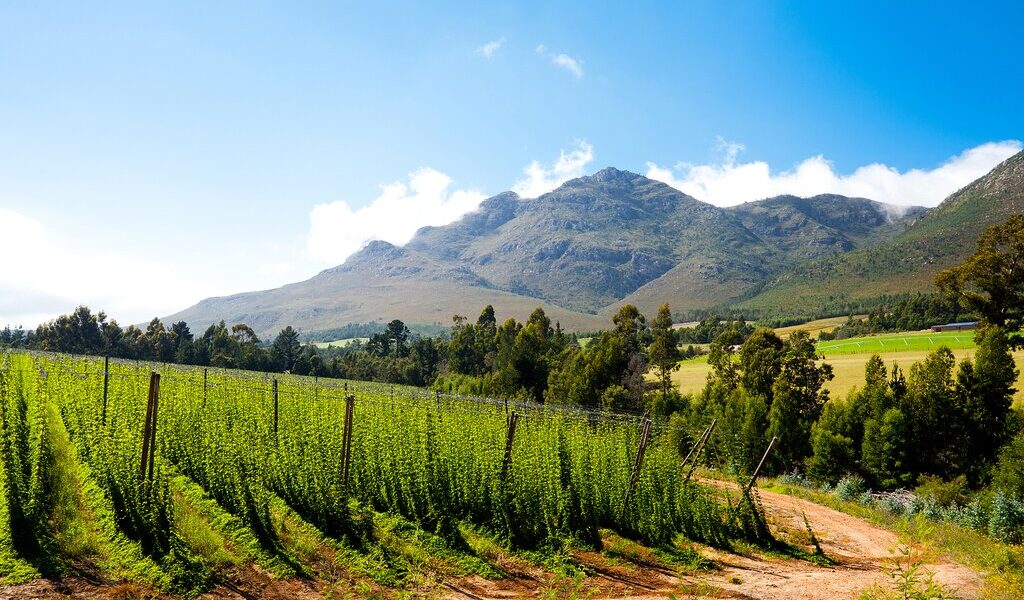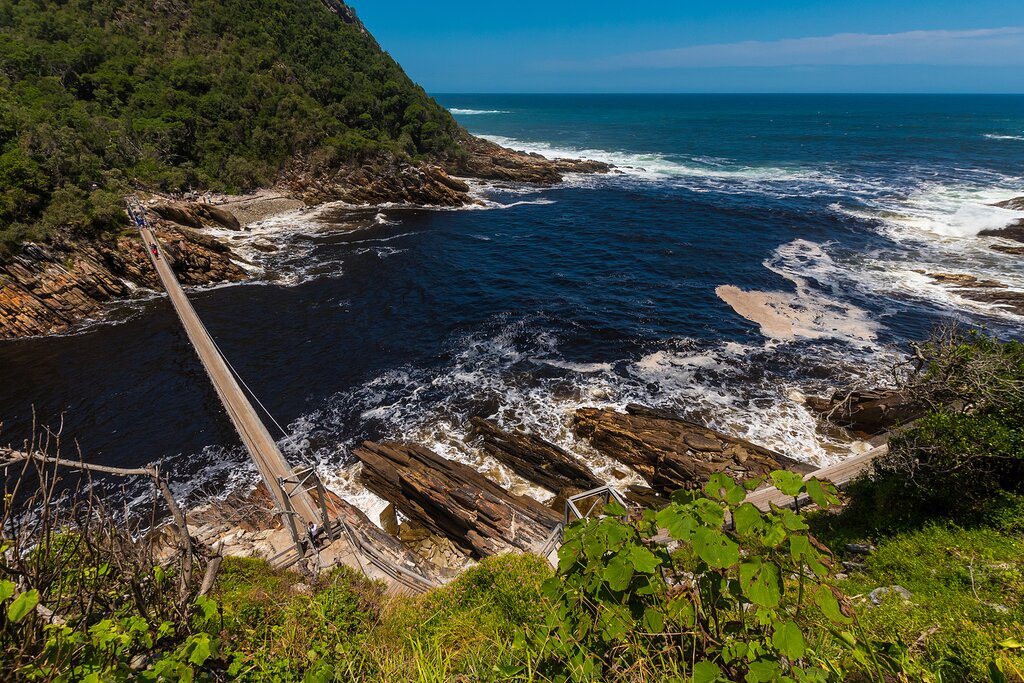
Driving South Africa’s famed Garden Route is suitable in any season; though there is always a chance of rain, it’s never enough to discourage a road trip or adventure outdoors. Let your interests determine when you hit the road. If you want to see whales, come in the winter, spring for the wildflowers, summer for the beaches, and fall for hiking. Awaiting exploration at any time, the Garden Route offers something for everyone.
## Seasonal Planning for a Garden Route Adventure
The **Garden Route** in South Africa is a truly spectacular and diverse landscape, a magnificent tapestry woven from mountains, lush forests, serene lagoons, and inviting beaches. Its name is derived from the renowned Garden Route National Park, a protected area that encapsulates much of its beauty. **George**, the largest city along the route, is often considered its unofficial capital, a vibrant hub brimming with activity and charm. Stretching over an impressive 190 miles (300 km) along South Africa’s southeastern coastline, from **Witsand** in the Western Cape province to the mouth of the **Storms River** in the Eastern Cape province, this captivating coastal stretch benefits from the country’s highest rainfall, resulting in the verdant, year-round greenery that characterizes the region. This consistent moisture ensures that the landscape remains vibrant and flourishing, a constant source of visual delight for travelers.
Each province that the Garden Route traverses experiences its own unique weather patterns and nuances. For instance, the **Western Cape** portion of the route tends to be rainier during the winter months, while the **Eastern Cape** generally experiences drier conditions. Moreover, the route’s fortunate location along the southern coast of the African continent blesses it with a pleasant maritime Mediterranean climate, recognized as one of the mildest climates in the world, rivaled only by Hawaii. This means that temperatures rarely reach extremes, neither unbearably hot nor frigidly cold, contributing significantly to the Garden Route’s enduring appeal, making it a desirable destination throughout the year. The consistently pleasant weather allows for a diverse range of activities and experiences, regardless of the specific month. However, given its proximity to the coast, visitors should always be prepared for unpredictable weather shifts and the possibility of rain at any time. Fortunately, the rain is often a fleeting overnight affair, and rarely does it persist long enough to discourage exploration and the enjoyment of the Garden Route’s many wonders. The fleeting nature of the rain ensures that outdoor activities can typically proceed without significant disruption.
The Garden Route presents an excellent road trip opportunity at any time of year, but each season offers a distinct and unique experience. The ideal month or season for your visit depends entirely on your personal interests and preferences. For those seeking beachside relaxation and invigorating hikes, the period from late spring to mid-fall (November to April) is generally considered the best. Whale watching enthusiasts will find winter and the beginning of summer (June to December, with peak sightings in August and October) the most rewarding. Finally, those captivated by the vibrant beauty of wildflowers should plan their trip for late winter or early spring (August and October), when the landscapes are awash in color. The high season, characterized by the warmest weather, spans from November to April. However, if you prefer to avoid large crowds, it’s advisable to steer clear of December and January, which tend to be the busiest months. Planning your trip around your specific interests will ensure that you make the most of your Garden Route adventure.
| Seasons | Pros | Cons | Best for | Where to Visit |
| Spring (Sep-Nov) | Enjoy the benefits of low shoulder season rates, meaning you can often find better deals on accommodations and activities. Also, experience fewer crowds at popular attractions, allowing for a more relaxed and intimate experience. The weather is characterized by warm, breezy days and clear skies, ideal for outdoor pursuits. | Be aware that the late September school holiday can draw a significant number of local tourists, leading to increased crowds in certain areas. This is a relatively short period, but it’s worth considering when planning your trip. | Spring is an excellent time for whale watching, as the majestic creatures migrate along the coast. It’s also a prime season for wildlife viewing, as many animals are giving birth. The landscapes come alive with wildflowers, particularly in October, creating a breathtaking spectacle. The weather is also suitable for enjoying the beaches in November, as well as hiking and biking adventures. | Consider visiting **Witsand** to witness the whale migration, **Wilderness** for its pristine beaches and natural beauty, **Knysna Lagoon** for its stunning scenery and water activities, **Robberg Nature Reserve** for its hiking trails and diverse wildlife, **Plettenberg Bay** for its vibrant atmosphere and beautiful beaches, and **Mossel Bay** for its historical significance and coastal charm. |
| Summer (Dec-Feb) | The weather is generally mild to warm and dry, making it ideal for outdoor activities. February is typically the hottest month of the year. | Expect peak crowds and inflated rates, especially over the Christmas, New Year, and summer holiday periods. Resorts and domestic flights tend to be fully booked, so it’s essential to plan well in advance. The Eastern Cape can experience rains during this period. | Summer is a good time to explore the less touristy beaches and enjoy long, leisurely hikes. | Explore **Noetzie Beach** in Knysna for a secluded and picturesque experience, **Victoria Bay Beach** for its surfing opportunities and stunning views, **Herolds Bay** for its family-friendly atmosphere, and **Brenton Beach** for its expansive sands and breathtaking sunsets. |
| Fall (Mar-May) | Enjoy the absence of crowds and the increased availability of hotel accommodations. | Be prepared for cooler overnight temperatures. | Fall is a pleasant time for visiting the beaches in March and April, and for embarking on hikes in March. | Consider a visit to the **Elephant Sanctuary Plettenberg Bay** for a memorable encounter with these gentle giants, **Monkeyland** for its unique primate experience, and **Wilderness National Park** for its diverse landscapes and outdoor activities. |
| Winter (Jun-Aug) | Take advantage of the mild to cool weather and the low season rates offered by many establishments. | The Western Cape can experience heavy rains during this period. July is typically the coldest month. Accommodations tend to book up quickly in August due to the whale watching season. | Winter is the ideal time for southern right whale watching. You can also enjoy the beauty of wildflowers, which often bloom in October. | Focus your attention on the **Eastern Cape** province, which experiences less rain during the winter months. **Plettenberg Bay** is a particularly good choice for whale watching and other activities. |
## Spring on the Garden Route (September to November)
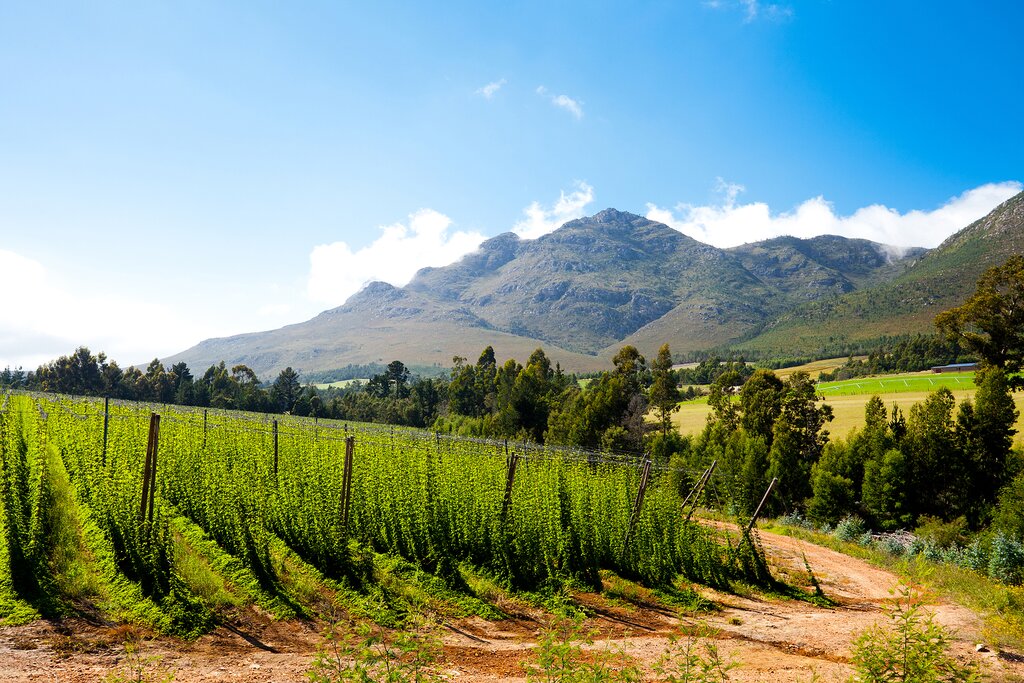
Driving along the Garden Route during spring is an undeniably delightful experience, particularly in the late spring months, when the weather tends to be drier and the temperatures are remarkably comfortable. In **George**, for example, average temperatures range from lows of 54°F (12°C) to highs of 73°F (23°C), creating perfect conditions for outdoor activities. During this time, the entire area undergoes a magnificent transformation, bursting into a kaleidoscope of colors as wildflowers, including the unique and endemic fynbos, come into full bloom. This creates a truly magical and picturesque landscape, offering breathtaking views at every turn. Spring also falls within the shoulder season, which means you’ll encounter fewer crowds compared to other times of the year, allowing for a more peaceful and intimate exploration of the region’s attractions. However, it’s worth noting that late September sees a surge in local tourism due to the short school vacation, which coincides with the **Hermanus Whale Festival**. This popular event draws large crowds to the coast and along the extensive 560-mile (900-km) stretch of the **Cape Whale Route**, so be sure to factor this into your plans if you’re visiting during this time. The Hermanus Whale Festival is a major draw, and while the crowds can be significant, the opportunity to witness these magnificent creatures is truly unforgettable.
For exceptional whale watching opportunities, consider a visit to **Witsand’s** Saint Sebastian Bay. This location is renowned for its calving southern right whales, providing unparalleled views that can be enjoyed directly from the shore. Alternatively, explore **Wilderness’** Dophins’ Point and Wilderness Beach, among other strategic vantage points. **Knysna’s** The Heads, Noetzie, and Brenton-on-Sea also offer excellent whale watching prospects. In addition to land-based viewing, Knysna is an ideal location for embarking on a boat trip, allowing for closer and more intimate encounters with humpbacks and southern right whales. However, spring on the Garden Route offers far more than just aquatic life viewing. The intimate town of Wilderness boasts secluded beaches, tranquil rivers, and shimmering lakes, providing a haven for those seeking peace and quiet. Knysna, in turn, presents a beautiful lagoon, scenic rivers, and verdant forests, making it a paradise for anglers and water sport enthusiasts. The variety of activities and landscapes ensures that there’s something for everyone to enjoy during the spring months.
Spring, like most of the year-round seasons, offers superb conditions for hiking. Be sure to explore the trails and breathtaking scenery of the **Robberg Nature Reserve**, a protected area renowned for its diverse landscapes and abundant wildlife. In addition to hiking and whale watching, birders will find themselves in paradise, with the opportunity to spot over 260 different species along the Garden Route. The region’s rich biodiversity makes it a haven for nature lovers of all kinds.
### Learn More
[Links Removed]
## Summer on the Garden Route (December to February)
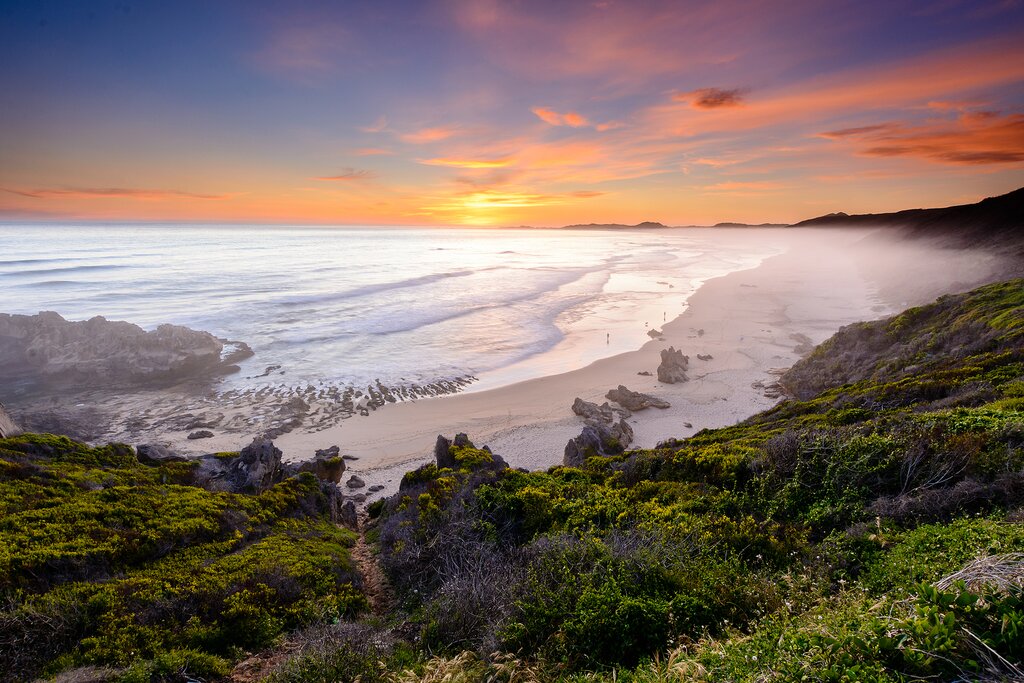
The summer months, from December to February, represent the peak of activity on the Garden Route. This is particularly true in late December, when school holidays commence, and local vacationers flock to the beaches and other attractions. The influx continues into January as the long summer school vacation extends through to mid-month. February is typically the hottest month of the year, with average temperatures in **George** ranging from a low of 61°F (16°C) to a high of 79°F (26°C). During this time, the inviting waters of the Indian Ocean reach a pleasant temperature of 70°F-75°F (21°C-24°C). Some of the most popular and busiest areas during the summer include **Hartenbos**, **Stilbaai**, and Mossel Bay, all of which offer a wide range of activities and attractions. However, the crowds tend to dissipate towards the end of January, and by February, the peak season has largely subsided, making it easier to secure accommodation “on the go.” Despite the initial crowds, the summer months offer a vibrant and energetic atmosphere, perfect for those seeking a lively vacation experience.
If you’re planning to travel the Garden Route during the summer months, it’s essential to be aware of the potential for heavy traffic on the popular sections of road. You should also anticipate long queues at popular attractions, such as **Tsitsikamma Park** with its iconic **Suspension Bridge** and the scenic two-mile (3 km) **Waterfall Trail**. To avoid the worst of the crowds, consider arriving at the park early, right when the gates open. Of course, the beaches are a major draw during the summer, offering opportunities for a variety of watersports or simply relaxing on the sand. For a less tourist-frequented experience, try **Noetzie Beach** in Knysna, **Victoria Bay Beach**, or **Herolds Bay**. And when the heat becomes intense, a visit to **Brenton Beach** by the Knysna Western Heads is highly recommended. Here, you’ll find several natural pools nestled between the rocks, offering a refreshing way to cool off. The diverse range of beaches ensures that there’s a perfect spot for every taste and preference.
### Learn More
[Links Removed]
## Fall on the Garden Route (March to May)

Fall on the Garden Route is characterized by continued pleasant weather, with March being the warmest month of the season. In **George**, average temperatures in March range from a low of 57°F (14°C) to a high of 77°F (25°C). However, March is also typically the wettest month, with an average of 10 days of rain. That said, throughout five months of the year, you can expect around nine days of rain, so this shouldn’t significantly deter travelers from visiting during this time. The fall season is perfect for exploration, hiking, and city sightseeing. Even as May arrives, temperatures remain mild, averaging lows of 50°F (10°C) and highs of 73°F (23°C), with two fewer days of rain compared to March. The mild temperatures and reduced rainfall make fall an ideal time for outdoor activities and exploring the region’s many attractions.
With the exception of the Easter holiday towards the end of March, when schools are closed and families head to the coasts for beaches, parks for camping, and cities for events and attractions, fall is considered a shoulder season. This translates to fewer crowds at popular venues and sites, less traffic on the roads, reduced hotel rates, and increased availability of accommodations. This makes it an excellent time to visit if you’re looking for a more relaxed and budget-friendly experience. Consider exploring **Wilderness National Park**, a treasure trove of stunning landscapes, including incredible birdlife, pristine beaches, lush forests, and majestic mountains. This diverse park offers opportunities for hiking, camping, fishing, and more. For unique wildlife encounters, mingle with roaming birds at **Birds of Eden** and playful monkeys at **Monkeyland**. The abundance of wildlife and natural beauty makes fall a truly rewarding time to visit the Garden Route.
### Events in Fall
**Knysna Literary Festival**, **Thesen Island**. For bookworms seeking a cultural experience, combine a tour along the Garden Route with this annual decade-old festival. The festival showcases South Africa’s top literary talent, offering readings and book signings. The venues are located around Thesen Island, a picturesque setting that adds to the festival’s charm.
### Learn More
[Links Removed]
## Winter on the Garden Route (June to August)
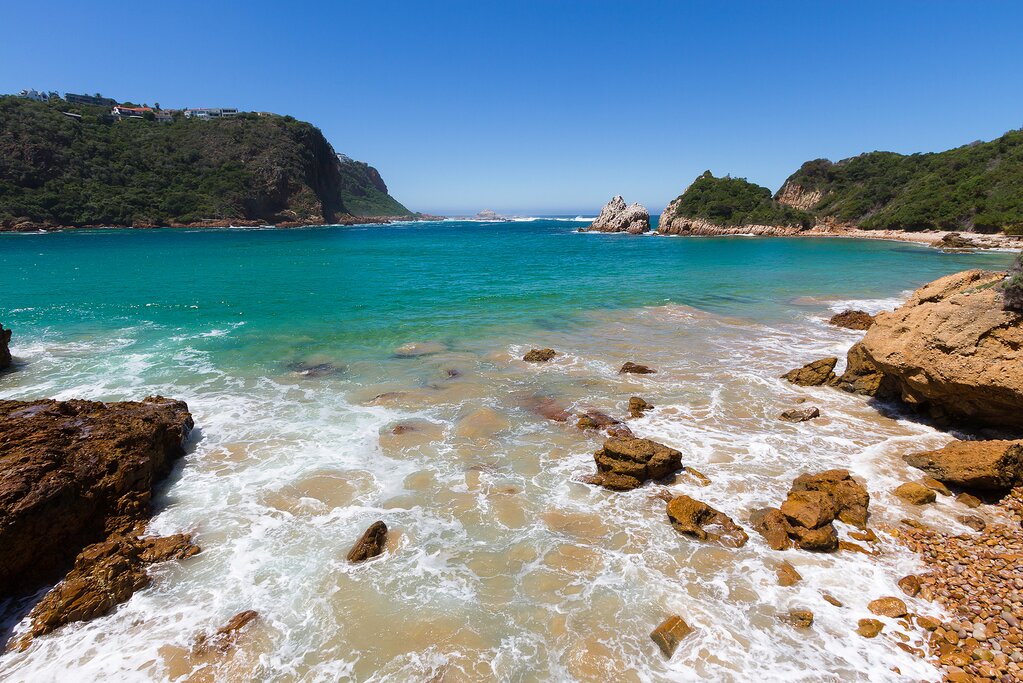
Winter on the Garden Route can be somewhat unpredictable, particularly in the Western Cape province, which experiences more rainfall than other areas along the route. However, in George, you can expect the least amount of rainfall in June (six days), along with the coldest temperatures of the season, averaging lows of 46°F (8°C) and highs of 68°F (20°C). As with other times of the year, expect cooler nights, and it’s advisable to pack layers of clothing and your bathing suit. As winter is considered the off-season, prices are generally lower, and cities are less crowded, especially in the Western Cape. This makes it an ideal time for budget-conscious travelers seeking a peaceful escape.
Meanwhile, further east, winter marks the beginning of the southern right whale watching season, which peaks in August. As a result, it’s important to book accommodation well in advance in prime locations such as **Plettenberg Bay**, and be prepared for potentially crowded roads. Despite the potential for crowds in certain areas, winter on the Garden Route has much to offer. If you’re interested in seeing elephants up close, check out **Elephant Sanctuary Plettenberg Bay** for an opportunity to interact with these gentle giants. For thrill-seekers, consider a visit to **Bloukrans Bridge Bungy** in **Knysna**, one of the world’s highest commercial bridge jumps at 709 feet (216 m) over the Bloukrans River. And for those interested in rescued predators, there’s **Jukani Wildlife Sanctuary**, home to a variety of fascinating creatures. The range of activities available ensures that there’s something for everyone to enjoy during the winter months.
### Events in Winter
**Knysna Oyster Festival**, **Knysna**. This 10-day festival is timed to coincide with the early July school holidays and offers a wide range of activities, from sporting events such as cycling and running to cooking classes and competitions, wine and whiskey tastings, live music, and, of course, all the oysters you can eat. It’s a vibrant and festive event that showcases the best of the region’s culinary and cultural offerings.
### Learn More
[Links Removed]
B-2286

